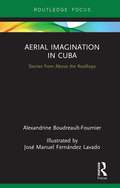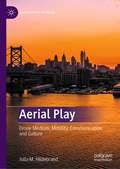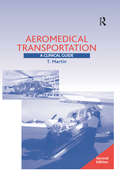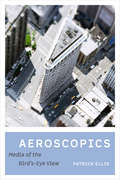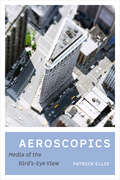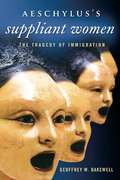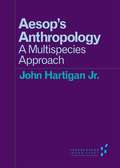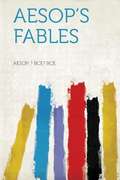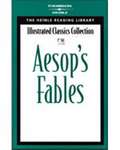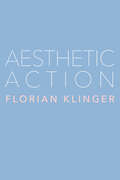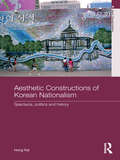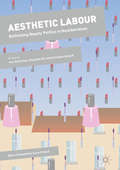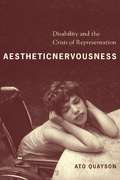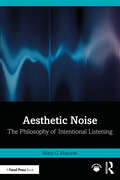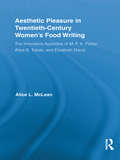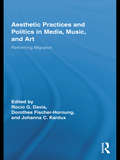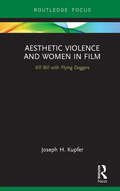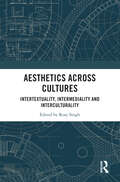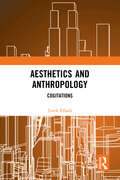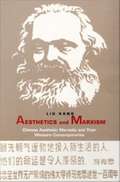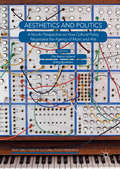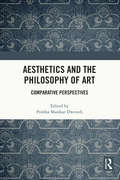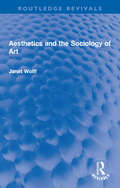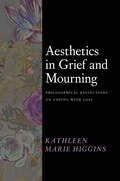- Table View
- List View
Aerial Imagination in Cuba: Stories from Above the Rooftops (Routledge Focus on Anthropology)
by Alexandrine Boudreault-FournierAerial Imagination in Cuba is a visual, ethnographic, sensorial, and poetic engagement with how Cubans imagine the sky as a medium that allows things to circulate. What do wi-fi antennas, cactuses, pigeons, lottery, and congas have in common? This book offers a series of illustrated ethno-fictional stories to explore various practices and beliefs that have seemingly nothing in common. But if you look at the sky, there is more than meets the eye. By discussing the natural, religious, and human-made visible and invisible aerial infrastructures—or systems of circulation—through short illustrated vignettes, Aerial Imagination in Cuba offers a highly creative way to explore the aerial space in Santiago de Cuba today.
Aerial Play: Drone Medium, Mobility, Communication, and Culture (Geographies of Media)
by Julia M. HildebrandThis book explores recreational uses of consumer drones from the lenses of media ecology, mobile communication, mobilities research, and science and technology studies. In this provocative ethnography, Julia M. Hildebrand discusses camera drones as mobile media for meaningful play. She thus widens perspectives onto the flying camera as foremost unmanned aircraft, spying tool, or dangerous toy towards a more comprehensive understanding of its potentials.How should we situate drone practices in recreational spaces? What ways of seeing, moving, and being do hobby drones open up? Across chapters about drone geography, communication, mobility, visuality, and human-machine relations, Aerial Play introduces novel frameworks for drone affordances, such as communication on the fly, disembodied mobilities, auratic vertical play, and drone-mindedness.In the mobile companionship with her own drone, Hildebrand contributes an innovative “auto-technographic” method for the self-reflective study of media and mobility. Ultimately, her grounded and aerial fieldwork illuminates new technological, mobile, visual, and social relations in everyday spaces.
Aeromedical Transportation: A Clinical Guide
by Terence MartinThis book focuses on the principles of aeromedical transport and includes latest research and new chapters on the transport of intensive care patients and medical emergencies/death in flight. It is intended for medical personnel whose duties include the transportation of the sick and injured by air.
Aeroscopics: Media of the Bird's-Eye View
by Patrick EllisIn 1900, Paris had no skyscrapers, no tourist helicopters, no drones. Yet well before aviation made aerial views more accessible, those who sought such vantages had countless options available to them. They could take in the vista from an observation ride, see a painting of the view from Notre-Dame, or overlook a miniature model city. In Aeroscopics, Patrick Ellis offers a history of the view from above, written from below. Richly illustrated and premised upon extensive archival work, this interdisciplinary study reveals the forgotten media available to the public in the Balloon Era and after. Ellis resurrects these neglected spectacles as "aeroscopics," opening up new possibilities for the history of aerial vision.
Aeroscopics: Media of the Bird's-Eye View
by Patrick EllisIn 1900, Paris had no skyscrapers, no tourist helicopters, no drones. Yet well before aviation made aerial views more accessible, those who sought such vantages had countless options available to them. They could take in the vista from an observation ride, see a painting of the view from Notre-Dame, or overlook a miniature model city. In Aeroscopics, Patrick Ellis offers a history of the view from above, written from below. Richly illustrated and premised upon extensive archival work, this interdisciplinary study reveals the forgotten media available to the public in the Balloon Era and after. Ellis resurrects these neglected spectacles as "aeroscopics," opening up new possibilities for the history of aerial vision.
Aeschylus's Suppliant Women
by Geoffrey W. BakewellThis book offers a provocative interpretation of a relatively neglected tragedy, Aeschylus's Suppliant Women. Although the play's subject is a venerable myth, it frames the flight of the daughters of Danaus from Egypt to Greece in starkly contemporary terms, emphasizing the encounter between newcomers and natives. Some scholars read Suppliant Women as modeling successful social integration, but Geoffrey W. Bakewell argues that the play demonstrates, above all, the difficulties and dangers noncitizens brought to the polis. Bakewell's approach is rigorously historical, situating Suppliant Women in the context of the unprecedented immigration that Athens experienced in the sixth and fifth centuries BCE. The flow of foreigners to Attika increased under the Pisistratids but became a flood following liberation, Cleisthenes, and the Persian Wars. As Athenians of the classical era became increasingly aware of their own collective identity, they sought to define themselves and exclude others. They created a formal legal status to designate the free noncitizens living among them, calling them metics and calling their status metoikia. When Aeschylus dramatized the mythical flight of the Danaids from Egypt in his play Suppliant Women, he did so in light of his own time and place. Throughout the play, directly and indirectly, he casts the newcomers as metics and their stay in Greece as metoikia. Bakewell maps the manifold anxieties that metics created in classical Athens, showing that although citizens benefited from the many immigrants in their midst, they also feared the effects of immigration in political, sexual, and economic realms. Bakewell finds metoikia was a deeply flawed solution to the problem of large-scale immigration. Aeschylus's Argives accepted the Danaids as metics only under duress and as a temporary response to a crisis. Like the historical Athenians, they opted for metoikia because they lacked better alternatives.
Aesop's Anthropology: A Multispecies Approach (Forerunners: Ideas First)
by John Hartigan Jr.Aesop&’s Anthropology is a guide for thinking through the perplexing predicaments and encounters that arise as the line between human and nonhuman shifts in modern life. Recognizing that culture is not unique to humans, John Hartigan Jr. asks what we can learn about culture from other species. He pursues a variety of philosophical and scientific ideas about what it means to be social using cultural dynamics to rethink what we assume makes humans special and different from other forms of life. Through an interlinked series of brief essays, Hartigan explores how we can think differently about being human.Forerunners: Ideas First is a thought-in-process series of breakthrough digital publications. Written between fresh ideas and finished books, Forerunners draws on scholarly work initiated in notable blogs, social media, conference plenaries, journal articles, and the synergy of academic exchange. This is gray literature publishing: where intense thinking, change, and speculation take place in scholarship.
Aesop's Fables
by S. A. HandfordAn illustrated collection of twenty-four Aesop fables selected from those populated only by animals, arranged in categories such as lion fables, fox fables, and wolf fables.
Aesthetic Action
by Florian KlingerIn this new book, Florian Klinger gives readers a basic action-theoretical account of the aesthetic. While normal action fulfills a determinate concept, Klinger argues, aesthetic action performs an indeterminacy by suspending the action's conceptual resolution. Taking as examples work by Tino Sehgal, Kara Walker, Mazen Kerbaj, Marina Abramović, Cy Twombly, and Franz Kafka, the book examines indeterminacy in such instances as a walk that is at once leisurely and purposeful, a sound piece that is at once joyous and mournful and mechanical, or a sculpture that at once draws one in and shuts one out. Because it has irresolution as its point, aesthetic action presents itself as an unsettling of ourselves, our ways, our very sense of who we are. As performers of such action, we don't recognize one another as bearers of a shared human form as we normally would, but find ourselves tasked anew with figuring out what sharing a form would mean. In conversation with philosophers such as Kant, Hegel, Wittgenstein, and Anscombe; political thinkers such as Marx and Lorde; and contemporary interlocutors such as Michael Thompson, Sebastian Rödl, and Thomas Khurana, Klinger's book makes a case for a conception of the human form that systematically includes the aesthetic: an actualization of the form that is indeterminate and nevertheless rational. The book gives the project of Western philosophical aesthetics a long-overdue formulation for our present that aims to do justice to contemporary aesthetic production as it actually exists. It will appeal to those working in philosophy, art, and political thought.
Aesthetic Constructions of Korean Nationalism: Spectacle, Politics and History (Asia's Transformations)
by Hong KalWhile most studies on Korean nationalism centre on textual analysis, Aesthetic Constructions of Korean Nationalism offers a different approach. It looks at expositions, museums and the urban built environment at particular moments in both colonial and postcolonial eras and analyses their discursive relations in the construction of Korean nationalism. By linking concepts of visual spectacle, urban space and governmentality, this book explores how such notions made the nation imaginable to the public in both the past and the present; how they represented a new modality of seeing for the state and contributed to the shaping of collective identities in colonial and postcolonial Korea. The author further examines how their different modes were associated with the change in governmentality in Korea. In addressing these questions, the book interprets the politics behind the culture of displays and shows both the continuity and the transformation of spectacles as a governing technology in twentieth-century Korea. Aesthetic Constructions of Korean Nationalism is a significant contribution to a study of the politics of visual culture in colonial and postcolonial Korea. The book will be of interest to students and scholars of Korean Studies, Culture and Heritage Studies and Asian Studies.
Aesthetic Labour: Rethinking Beauty Politics in Neoliberalism (Dynamics of Virtual Work)
by Ana Sofia Elias Rosalind Gill Christina ScharffThis volume approaches questions about gender and the politics of appearance from a new perspective by developing the notion of aesthetic labour. Bringing together feminist writing regarding the 'beauty myth' with recent scholarship about new forms of work, the book suggests that in this moment of ubiquitous photography, social media, and 360 degree surveillance, women are increasingly required to be 'aesthetic entrepreneurs', maintaining a constant state of vigilance about their appearance. The collection shows that this work is not just on the surface of bodies, but requires a transformation of subjectivity itself, characterised by notions of personal choice, risk-taking, self-management, and individual responsibility. The book includes analyses of online media, beauty service work, female genital cosmetic surgery, academic fashion, self-help literature and the seduction community, from a range of countries. Discussing beauty politics, postfeminism, neoliberalism, labour and subjectivity, the book will be of interest to scholars and students with an interest in Gender, Media Studies, Cultural studies, Sociology, Social Psychology and Management Studies. "This highly engaging, smart, and wide-ranging collection analyzes how, under the self-governing mandates of neoliberalism, the demands that girls and women regulate and control their bodies and appearance have escalated to new, unforgiving levels. A special strength of the book is its emphasis on the rise of 'aesthetic labour' as a global, transnational and ever-colonizing phenomenon that seeks to sweep up women of all races, ages and locales into its disciplinary grip. Highly recommended. " -Susan J Douglas, University of Michigan, USA -Melissa Gregg, Intel Corporation, USA "This book incisively conceptualizes how neo-liberalist and postfeminist tendencies are ramping up pressures for glamour, aesthetic, fashion, and body work in the general public. In a moment when YouTube 'makeup how to' videos receive millions of hits; what to wear and how to wear it blogs clock massive followings; and staying 'on brand' is sold to us as the key to personal and financial success, 'aesthetic entrepreneurship' is bound to become a go-to concept for anyone seeking to understand the profound shifts shaping labor and life in the 21st century. " -Elizabeth Wissinger, City University of New York, USA
Aesthetic Nervousness: Disability and the Crisis of Representation
by Ato QuaysonFocusing primarily on the work of Samuel Beckett, Toni Morrison, Wole Soyinka, and J. M. Coetzee, Ato Quayson launches a thoroughly cross-cultural, interdisciplinary study of the representation of physical disability. Quayson suggests that the subliminal unease and moral panic invoked by the disabled is refracted within the structures of literature and literary discourse itself, a crisis he terms "aesthetic nervousness." The disabled reminds the able-bodied that the body is provisional and temporary and that normality is wrapped up in certain social frameworks. Quayson expands his argument by turning to Greek and Yoruba writings, African American and postcolonial literature, depictions of deformed characters in early modern England and the plays of Shakespeare, and children's films, among other texts. He considers how disability affects interpersonal relationships and forces the character and the reader to take an ethical standpoint, much like representations of violence, pain, and the sacred. The disabled are also used to represent social suffering, inadvertently obscuring their true hardships.
Aesthetic Noise: The Philosophy of Intentional Listening
by Mary G. MazurekAesthetic Noise: The Philosophy of Intentional Listening considers the complex nature of noise within the framework of philosophical filtering, examining how, if noise is engaged with aesthetically, it can produce profound experiences and understandings.Applying the philosophies of Edmund Burke, Martin Heidegger, Jacque Derrida, and Julia Kristeva to works by Luigi Russolo, John Cage, Steve Reich, Alison Knowles, Annea Lockwood, Alyce Santoro, and Sunn O))), this book explores noise as an art material, and ultimately how it can become a tool for activism and expanded creative possibilities. It demonstrates that, by engaging multiple philosophies in concert, the value of aesthetic noise is amplified, thus allowing the listener to better appreciate noise and its possibilities.Providing greater insights into noise as an aesthetic material, Aesthetic Noise will be of interest to researchers and students of sound studies, philosophy, and sound art, as well as sound designers, artists, musicians, and composers.
Aesthetic Pleasure in Twentieth-Century Women's Food Writing: The Innovative Appetites of M.F.K. Fisher, Alice B. Toklas, and Elizabeth David (Routledge Studies in Twentieth-Century Literature)
by Alice McLeanThis book explores the aesthetic pleasures of eating and writing in the lives of M. F. K. Fisher (1908-1992), Alice B. Toklas (1877-1967), and Elizabeth David (1913-1992). Growing up during a time when women's food writing was largely limited to the domestic cookbook, which helped to codify the guidelines of middle class domesticity, Fisher, Toklas, and David claimed the pleasures of gastronomy previously reserved for men. Articulating a language through which female desire is artfully and publicly sated, Fisher, Toklas, and David expanded women’s food writing beyond the domestic realm by pioneering forms of self-expression that celebrate female appetite for pleasure and for culinary adventure. In so doing, they illuminate the power of genre-bending food writing to transgress and reconfigure conventional gender ideologies. For these women, food encouraged a sensory engagement with their environment and a physical receptivity toward pleasure that engendered their creative aesthetic.
Aesthetic Practices and Politics in Media, Music, and Art: Performing Migration
by Rocío G. DavisThis volume analyzes innovative forms of media and music (art installations, television commercials, photography, films, songs, telenovelas) to examine the performance of migration in contemporary culture. Though migration studies and media studies are ostensibly different fields, this transnational collection of essays addresses how their interconnection has shaped our understanding of the paradigms through which we think about migration, ethnicity, nation, and the transnational. Cultural representations intervene in collective beliefs. Art and media clearly influence the ways the experience of migration is articulated and recalled, intervening in individual perceptions as well as public policy. To understand the connection between migration and diverse media, the authors examine how migration is represented in film, television, music, and art, but also how media shape the ways in which host country and homeland are imagined. Among the topics considered are new mediated forms for representing migration, widening the perspective on the ways these representations may be analyzed; readings of enactments of memory in trans- and inter-disciplinary ways; and discussions of globalization and transnationalism, inviting us to rethink traditional borders in respect to migration, nation states, as well as disciplines.
Aesthetic Violence and Women in Film: Kill Bill with Flying Daggers (Routledge Focus on Feminism and Film)
by Joseph H. KupferAesthetic Violence and Women in Film is a highly readable and timely analysis of the intersection of two recent cinematic trends in martial arts films: aesthetic violence and warrior women. Joseph Kupfer establishes specific categories of aesthetic film violence, including hyper-violence, a visual style that emphasizes the sensuous surface of physical destruction and surreal violence, when spectacular imagery and gravity-defying dance replace blood and gore. He then goes on to outline the ascendancy during the past decades of female characters to the status of hero in action films. Interweaving these two subjects, the book reveals how women warriors instigate and animate the models of aesthetic violence introduced. The hyper-violence of Kill Bill celebrates the triumphs of the Bride, whose maiming and dismemberment of enemies produce brilliant red plumes and silvered geysers of blood. The surrealistic violence in Crouching Tiger, Hidden Dragon and The House of Flying Daggers creatively elevates violence from earthbound mayhem to an enchanting aerial display of female-dominated acrobatics. Both film-stories are driven by the plight and aspirations of female combatants, suggesting an affinity between women and the transfiguration of fighting wrought by surrealistic violence. By elevating the significance of violence in action films and linking it together with the growing popularity of central female characters in this genre, Aesthetic Violence and Women in Film will be of interest to students and scholars in film studies, popular culture, gender studies, aesthetics, and social philosophy.
Aesthetics across Cultures: Intertextuality, Intermediality and Interculturality
by Rosy SinghThis book critically examines the "mutual illuminations" between literature, religion, architecture, films, performative arts, paintings, woodworks, memes and masks cutting across time and space. Architecture is a good example where the eventual success of a project depends on the harmony between physical sciences and aesthetics, design and planning, knowledge of building material, the local climate and awareness of cultural sensibilities. This volume affirms that aesthetics and arts are deeply linked through existential issues of who I am. The chapters in this volume present diverse discursive structures highlighting the in-between spaces between various art forms and mediums, such as: • Architecture, literature and memory • Kafka in SoHo; Kafka and Bernhard • Kirchner’s woodcuts; pictorial and stage representations of E.T.A. Hoffmann • Hesse’s fairy tales; translations of Pañcatantra • Nietzsche, ritual arts and face masks; martyrdom in La chanson de Roland • Goethe and Hafiz; Indian thought in Martin Buber • Rhythms of the "Third" across cultures • Dadaism and contemporary memes This book examines these sublime linkages in a comparative and interdisciplinary way. Engaging and intersectional, this volume will appeal to students and scholars of arts and aesthetics, literature, philosophy, architecture, sociology, translation studies and readers who are interested in cultural, intertextual, intermedial and comparative studies.
Aesthetics and Anthropology: Cogitations
by Tarek ElhaikThis book focuses on the reconfiguration of aesthetic anthropology into an anthropological problem of cogitation, opening up a fascinating new dialogue between the domains of anthropology, philosophy, and art. Tarek Elhaik embarks on an inquiry composed of a series of cogitations based on fieldwork in an ecology of artistic and scientific practices: from conceptual art exhibitions to architectural environments; from photographic montages to the videotaping of spirit seances; from artistic interventions in natural history museums to ongoing dialogues between performance artists and marine scientists. The chapters examine the image-work, ethical demands, and aesthetic struggles of interlocutors including artists Mathias Goeritz, Mounir Fatmi, Silvia Gruner, Joan Jonas, and Patricia Lagarde.
Aesthetics and Marxism: Chinese Aesthetic Marxists and Their Western Contemporaries
by Liu KangAlthough Chinese Marxism--primarily represented by Maoism--is generally seen by Western intellectuals as monolithic, Liu Kang argues that its practices and projects are as diverse as those in Western Marxism, particularly in the area of aesthetics. In this comparative study of European and Chinese Marxist traditions, Liu reveals the extent to which Chinese Marxists incorporate ideas about aesthetics and culture in their theories and practices. In doing so, he constructs a wholly new understanding of Chinese Marxism. Far from being secondary considerations in Chinese Marxism, aesthetics and culture are in fact principal concerns. In this respect, such Marxists are similar to their Western counterparts, although Europeans have had little understanding of the Chinese experience. Liu traces the genealogy of aesthetic discourse in both modern China and the West since the era of classical German thought, showing where conceptual modifications and divergences have occurred in the two traditions. He examines the work of Mao Zedong, Lu Xun, Li Zehou, Qu Qiubai, and others in China, and from the West he discusses Kant, Schiller, Schopenhauer, and Marxist theorists including Horkheimer, Adorno, Benjamin, and Marcuse. While stressing the diversity of Marxist positions within China as well as in the West, Liu explains how ideas of culture and aesthetics have offered a constructive vision for a postrevolutionary society and have affected a wide field of issues involving the problems of modernity. Forcefully argued and theoretically sophisticated, this book will appeal to students and scholars of contemporary Marxism, cultural studies, aesthetics, and modern Chinese culture, politics, and ideology.
Aesthetics and Politics: A Nordic Perspective on How Cultural Policy Negotiates the Agency of Music and Arts (New Directions in Cultural Policy Research)
by Ole Marius Hylland Erling BjurströmThrough comparative and integrated case studies, this book demonstrates how aesthetics becomes politics in cultural policy. Contributors from Norway, Sweden and the UK analyse exactly what happens when art is considered relevant for societal development, at both a practical and theoretical level. Cultural policy is seen here as a mechanism for translating values, that through organized and practical aesthetical judgement lend different forms of agency to the arts. What happens when aesthetical value is reinterpreted as political value? What kinds of negotiations take place at a cultural policy ground level when values are translated and reinterpreted? By addressing these questions, the editors present an original collection that effectively centralises and investigates the role of aesthetics in cultural policy research.
Aesthetics and the Philosophy of Art: Comparative Perspectives
by Prabha Shankar DwivediThis volume brings together the finest research on aesthetics and the philosophy of art by stalwart critics and leading scholars in the field. It discusses various themes, such as the idea of aesthetic perception, the nature of aesthetic experience, attitude theory, the relation of art to morality, representation in art, and the association of aesthetics with language studies in the Indian tradition. It deliberates over the theories and views of Aristotle, Freud, Plato, Immanuel Kant, T. S. Eliot, George Dickie, Leo Tolstoy, R. G. Collingwood, Michael H. Mitias, Monroe C. Beardsley, and Abhinavagupta, among others. The book offers a comparative perspective on Indian and Western approaches to the study of art and aesthetics and enables readers to appreciate the similarities and differences between the conceptions of aesthetics and philosophy of art on a comparative scale detailing various aspects of both. The first of its kind, this key text will be useful for scholars and researchers of arts and aesthetics, philosophy of art, cultural studies, comparative literature, and philosophy in general. It will also appeal to general readers interested in the philosophy of art.
Aesthetics and the Revolutionary City: Real and Imagined Havana (Studies of the Americas)
by James Clifford KentAesthetics and the Revolutionary City engages in alternative ways of reading foreign visual representations of Havana through analysis of advertising images, documentary films, and photographic texts. It explores key narratives relating to the projection of different Havana imaginaries and focuses on a range of themes including: pre-revolutionary Cuba; the dream of revolution; and the metaphor of the city “frozen-in-time.” The book also synthesizes contemporary debates regarding the notion of Havana as a real and imagined city space and fleshes out its theoretical insights with a series of stand-alone, important case studies linked to the representation of the Cuban capital in the Western imaginary. The interpretations in the book bring into focus a range of critical historical moments in Cuban history (including the Cuban Revolution and the “Special Period”) and consider the ways in which they have been projected in advertising, documentary film and photography outside the island.
Aesthetics and the Sociology of Art (Routledge Revivals)
by Janet WolffFirst published in 1983, Aesthetics and the Sociology of Art provides a lucid account of two divergent tendencies in the study of aesthetics. At the one extreme, traditional aestheticians have assumed that art and literature are wholly independent, following only the laws and inspirations of artists and artistic movements, and that the question of aesthetic value is accordingly unproblematic. At the other extreme, some sociologists have treated works of art as no more than manifestations of the socio-economic circumstances which produce them, arguing that aesthetic value is therefore entirely relative matter. Janet Wolff shows how both the extreme positions are untenable, and argues convincingly that we must accept that the conceptions and criteria of aesthetic value are socially constructed and inevitably ideological, while stopping short of the reductionist alternative which fails to recognise the irreducible questions of pleasure and of aesthetic discourse. This book provides an invaluably clear guide both to old debates and to otherwise obscure modern controversies, which will be welcomed both by students and scholars in the sociology of art, in aesthetics, in art history, and in literary criticism.
Aesthetics in Grief and Mourning: Philosophical Reflections on Coping with Loss
by Kathleen Marie HigginsA philosophical exploration of aesthetic experience during bereavement. In Aesthetics of Grief and Mourning, philosopher Kathleen Marie Higgins reflects on the ways that aesthetics aids people experiencing loss. Some practices related to bereavement, such as funerals, are scripted, but many others are recursive, improvisational, mundane—telling stories, listening to music, and reflecting on art or literature. Higgins shows how these grounding, aesthetic practices can ease the disorienting effects of loss, shedding new light on the importance of aesthetics for personal and communal flourishing.
